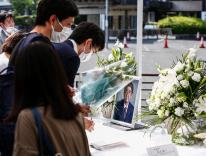Bad Information
Ronald Osborn’s article “Still Counting: How Many Iraqis Have Died?” (February 11) was informative, but recirculated a number of errors and myths regarding the Iraq death counts. For example, Osborn wrote: “The 2006 Lancet study (building on an earlier 2004 survey by the same authors) was the first scientific attempt to determine how many Iraqis had died from all causes during the war. It was also the first analysis of Iraqi war deaths to be published in a peer-reviewed academic journal.” This is mistaken—it’s a widely circulated Web myth. The 2004 Lancet study was preceded by a much larger scientific study, the 2004 UNDP “Iraq Living Conditions Survey” (ILCS).
Like the Lancet studies, ILCS was an epidemiological cluster-sample survey. It surveyed over 21,000 Iraqi households (compared to approximately 1,800 in the 2006 Lancet study). The Lancet study authors (Gilbert Burnham, Les Roberts, et al.) were aware of the UNDP study and referenced it.
Osborn also circulates a few discredited myths about the Iraq Body Count (IBC)—for example, when he writes, “The organization, some have suggested, might therefore more accurately be called the ‘Iraq English Media Body Count.’” This “English media” myth originates in a misunderstanding over IBC’s sources. IBC monitors around 70 major non-Western sources, along with 120 Western sources.
It’s noteworthy that Osborn writes at length about alleged problems with the IBC and WHO/IFHS studies, but fails to mention scientific criticism of the Lancet studies. It appears that he has taken much of his information from blogs and comment pieces rather than from the scientific literature. In fact, a review of the scientific research reveals at least five peer-reviewed studies noting serious problems with the Lancet surveys, but none seriously challenging the work of the WHO/IFHS or IBC studies.
There are two key reasons why the WHO study is viewed as more authoritative. First, external analysis of its data set has successfully withstood more expert scrutiny. Second, its survey teams interviewed about five times as many people; a larger study sample size reduces the risk that deaths are over- or under-represented in the data.
Robert Shone
London, U.K.
The Author Replies
I appreciate Robert Shone’s interest in the question of Iraqi deaths. I must, however, correct several misstatements regarding my article in his letter.
Shone alleges that my description of the Lancet study as “the first scientific attempt to determine how many Iraqis had died from all causes of the war” to be “published in a peer-reviewed academic journal” is incorrect, citing the 2004 UNDP “Iraq Living Conditions Survey.” But the initial Lancet study was published in October 2004, whereas the UNDP survey was released in May 2005. Further, the UNDP study was not designed as a mortality survey. It was a general health survey that included limited questions about war-related deaths, resulting in a very imprecise estimate. It was published as a report by the UN but not in any peer-reviewed academic journal.
Regarding the Iraq Body Count’s methodology, I nowhere suggested that the IBC uses only Western media sources. What I wrote was that they use exclusively English-language media or works translated into English by others. I would refer Shone to the methodology section of the IBC’s own Web site, which explains: “The project collects and analyses reports written or published in the English language, though not always originating in it.” The IBC does not employ its own team of translators.
Shone is also incorrect in suggesting that my article was uncritical of the Lancet study or based only on popular, nonacademic sources. While it is true that I did not discuss many of the criticisms that have been made of the Lancet study in a variety of journal articles (space considerations did not permit this), I made very clear that there is an “acrimonious” dispute between the authors of the studies and scholars closely connected to them. I called attention to David Marker’s review in Public Opinion Quarterly as an example of balanced, critical, and nonpartisan scholarly opinion. I warned that there are “several possible sources of significant bias” in the Lancet’s figures, including major sampling errors. I concluded that its findings should be viewed with “extreme caution.”
My article was by no means an endorsement of the Lancet study’s figures. If I had simply accepted its findings uncritically, then following the IBC’s trend line (which I accept and which more than doubles violent deaths after June 2006, the Lancet study’s cutoff date), I would have argued for an excess mortality figure today of more than one million lives. I did not make such a claim but instead pointed out that the three most important studies of Iraqi casualties to date all support a conservative estimation of hundreds of thousands of “excess” deaths from all causes during the war.
This includes the 2008 WHO/IFHS study, which Shone prefers. WHO/IFHS reported 150,000 violent deaths occurring through June 2006. This figure does not include any war-related but nonviolent deaths. It does not include any deaths after June 2006, even though the IBC reports that more than half of all documented violent deaths occurred after this date.
Ronald Osborn
Are Professors ‘Labor’?
Paul Moses’s May 20 article on the question of permitting a faculty union at Manhattan College (“Which Side Are They On?”) would be strengthened by placing the issue in the context of the Supreme Court’s decision in NLRB v. Yeshiva (1980). The Court ruled that private colleges may refuse to allow faculty unionization because faculty are not “labor” under the terms of the National Labor Relations Act. Because faculty have decision rights on such matters as curriculum, appointment, and promotion, they would be “managers” under prevailing law. The Court’s position is echoed in the American Association of University Professors’ direction that university governance is essentially “joint,” involving faculty, administration, and trustees. Faculty at public universities generally enjoy the same decision rights as those at private institutions. Nevertheless, as the recent controversy in Wisconsin over collective bargaining highlighted, faculty unions are relatively common in state systems as a result of specific state laws permitting unionization of public employees. Private colleges could emulate the states and, for whatever reason, decide to accept faculty unionization, but they cannot be compelled to do so by law.
The reason that NLRB v. Yeshiva is important in understanding the situation at Manhattan College is that the effort there is to unionize adjunct faculty. Adjunct faculty are part-time or even full-time teachers who are not on a tenure track and have no decision rights in the governance of the college. They do not vote in faculty meetings or have a formal role in decisions about hiring or curriculum. Adjunct faculty are clearly “labor” under the terms of existing law. If conditions are met for holding a vote on unionization of adjuncts, the Manhattan College administration can attempt to persuade the participants to reject unionization. Not all faculty unionization efforts result in establishment of unions. At some flagship state universities, faculty unionization has been rejected even though permitted under law.
Since it is estimated that more than 60 percent of college teaching across the country is now carried out by adjunct faculty, the question of their unionization is a major issue not only in itself but for what it implies about the traditional tenure system. Is it equitable that an ever-shrinking coterie of the tenured should enjoy decision rights—not to mention salaries and benefits—that are not shared in any way by those doing a great bulk of the classroom work?
Dennis O’Brien
Middlebury, Vt.
A Legacy Forgotten
As a graduate of Manhattan College’s School of Business, I was disappointed and appalled at the anti-union actions taken by the college. They ran contrary to the whole history of Catholic social teaching. Starting in 1848 with Bishop von Ketteler in Germany and down through the next century and a half, Catholic teaching has supported the right of employees to free association in their place of employment.
A number of Manhattan College graduates were inspired by these teachings, and they devoted their careers to implementing social justice in unions and conscience-minded corporations. In my experience as a former Executive Secretary of the Association of Catholic Trade Unionists and retired Industrial Relations executive of Ford Motor Company and Bundy Corporation, I have found that these social principles have been for the good of both workers and corporations. For President Brennan O’Connell to say there is a “massive body of thinking and interpretation that has all sort of complexities” regarding these Catholic social principles is to hide behind legalese and cherry-picking. One has to wonder whether Manhattan College has succumbed to the pressures of certain anti-union corporate-minded forces.
James J. McElroy
Farmington, Mich.
Please email comments to [email protected] and join the conversation on our Facebook page.
Previous Story
A Special Species
Next Story
195 Outs


